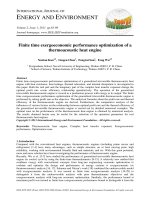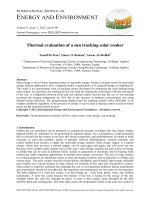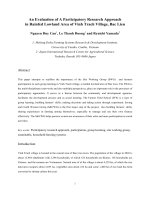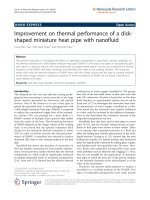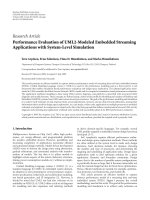Performance evaluation of a solar assisted heat pump drying system
Bạn đang xem bản rút gọn của tài liệu. Xem và tải ngay bản đầy đủ của tài liệu tại đây (3.82 MB, 154 trang )
PERFORMANCE EVALUATION OF A SOLAR
ASSISTED HEAT PUMP DRYING SYSTEM
SHEK MOHAMMOD ATIQURE RAHMAN
NATIONAL UNIVERSITY OF SINGAPORE
2003
PERFORMANCE EVALUATION OF A SOLAR
ASSISTED HEAT PUMP DRYING SYSTEM
Founded 1905
SUBMITTED BY
SHEK MOHAMMOD ATIQURE RAHMAN
(B.Sc.Eng.,BUET.)
A THESIS SUBMITTED
FOR THE DEGREE OF MASTER OF ENGINEERING
DEPARTMENT OF MECHANICAL ENGINEERING
NATIONAL UNIVERSITY OF SINGAPORE
2003
Acknowledgements
ACKNOWLEDGEMENTS
For the successful completion of the project, firstly, the author would like to express
his gratitude toward Almighty Allah for his blessing and mercy.
The author would like to express his profound thanks and gratitude to his project
supervisor Associate Professor M.N.A. Hawlader for giving an opportunity to work
under his guidance, advice, and patience throughout the project. In particular,
necessary suggestions and recommendations of project supervisor for the successful
completion of this research work have been invaluable.
The author is also grateful to his colleague Mr. Jahangeer for his active co-operation
and valuable advice throughout the project.
The author extends his thanks to all the technical staffs in the thermal division,
particularly Yeo Khee Ho, Hung-Ang Yan Leng, Low Kim Tee Desmond, Tan Tiong
Thiam, Anwar Sadat and Roselina Abdullah for their assistance during the fabrication
of test rig and performance of experiments.
The author expresses his heartfelt thanks to all of his friends who have provided
inspiration for the completion of project.
Finally, the author extends his gratitude to his parents, wife, daughter and other family
members for their patience and support throughout this work.
The author would like to acknowledge the financial support for this project provided
by the National University of Singapore in the form of Research Scholarship.
i
Table of Contents
TABLE OF CONTENTS
Page
ACKNOWLEDGEMENTS
i
TABLE OF CONTENTS
ii
SUMMARY
vi
NOMENCLATURE
ix
LIST OF FIGURES
xi
LIST OF TABLES
xv
CHAPTER
1
INTRODUCTION
1
1.1
Open Air Sun Drying
2
1.2
Indirect Solar Drying
3
1.3
Heat Pump Drying
4
1.4
Solar Assisted Heat Pump Drying
5
CHAPTER
2
LITERATURE REVIEW
7
CHAPTER
3
EXPERIMENTS
17
3.1
Description of the Setup
17
3.1.1
Air flow path
18
3.1.2
Refrigerant flow path
19
3.2
Selection of Components
21
3.2.1
21
Evaporator -collector
ii
Table of Contents
CHAPTER
CHAPTER
3.2.2
Compressor
23
3.2.3
Air-cooled condenser
24
3.2.4
Water-cooled condenser
24
3.2.5
Thermostatic expansion valve
25
3.2.6
Air collector
25
3.2.7
Blower
26
3.2.8
Electric heater
26
3.2.9
Dryer
26
3.2.10 Evaporator/de-humidifier
27
3.3
Instrumentation
27
3.4
Experimental Procedure
29
3.5
Drying Test
30
3.6
Collector Test
32
3.7
Error Analysis
32
4
LOCAL METEOROLOGICAL DATA
36
4.1
Climatic Condition of Singapore
36
4.2
Model for Meteorological Data for Singapore
38
SIMULATION AND OPTIMIZATION
43
Simualtion
43
5.1.1
43
5
5.1
Simualtion Methodology
iii
Table of Contents
5.2
CHAPTER
48
5.2.1 Economic analysis
48
5.2.2 Economic evaluation methodology
53
6
RESULTS AND DISCUSSION
56
6.1
Experimental Results
56
6.1.1
Drying characteristics
56
6.1.2
Performance parameters
72
6.2 Comparison Between Experimental
and Simulation Results
88
6.3
CHAPTER
Optimisation
7
6.2.1
Product temperature
88
6.2.2
Moisture content
89
6.2.3
Co-efficient of performance (COP)
90
6.2.4
Collector efficiency
92
6.2.5
Solar fraction (SF)
94
Cost Analysis of the System
96
6.3.1
Pay back period of the system
96
6.3.2
Optimum variables
99
CONCLUSIONS
101
RECOMMENDATIONS
104
REFERENCES
105
iv
Table of Contents
APPENDIX A
Calibration Graph
114
APPENDIX B
Experimental and Simulation results
118
v
Summary
SUMMARY
Most agricultural products contain a high percentage of water and, therefore,
considered highly perishable. Losses of agricultural product in developing countries
are significantly higher. The post-harvest losses of agricultural products can be
reduced drastically by using proper drying technique. Product quality and energy
requirement are very important considerations in drying technology. Singapore is a
country of abundant solar irradiation and high ambient temperature throughout the
year. For this meteorological condition, a solar assisted heat pump drying system was
designed, fabricated, and tested. The dryer, in the present study, is used to analyse the
drying characteristics of the food grains. The drying chamber is scaled down in size to
make it convenient to carry out the drying experiment by limiting the quantity of
drying material. In actual situation, this drying chamber can be scaled up to dry higher
quantity of material. An hourly energy analysis is carried out to examine the amount of
energy that can be derived from the system. This energy analysis can be used to
perform a scale-up of the drying chamber.
The system mainly comprises a compressor, water condenser, evaporator-collector,
thermostatic expansion valve, air collector, auxiliary heater, drying chamber,
dehumidifier, and blower. There are two distinct paths, the air and the refrigerant
R134a, to transport energy from one location to another. Two evaporators, fitted in
parallel mode, are used in the heat pump circuit, one acting as a dehumidifier and the
other as a solar collector. Once the air from the dryer exit has passed through the
dehumidifier, it enters an air collector, absorbs solar energy and transfers it to the
drying medium leading to an increase in temperature. Additional heating is provided at
vi
Summary
the condenser and, if necessary, at the auxiliary heater to achieve the desired condition.
A data acquisition system is used to record and monitor different parameters required
for the evaluation of the system performance.
A series of experiments were conducted at wide range of operating conditions by using
different agricultural food grains under the meteorological conditions of Singapore.
The experiments consist of drying of green beans, paddy, and grams with the careful
examination of its drying characteristic while monitoring the performance of the key
components like solar collectors, dehumidifier and condensers. On the analysis of
drying characteristics of the food grains, the three principle process parameters are
considered: drying air temperature, airflow rate and the effect of dehumidification. A
series of drying characteristics curve have been plotted to examine the effect of these
parameters on the drying time. The nature of the drying rate and diffusivity of the
above three materials are also examined. The collector is one of the most important
components in a solar drying system. To investigate the performance of evaporatorcollector and air collector, tests were conducted according to the ASHRE standard. For
the evaluation of performance of the system, solar fraction (SF) and coefficient of
performance (COP) are considered. Experimental results were analysed and, finally,
compared with simulation results. Good agreement was found between simulation and
experimental results, as stated in the results and discussion section of this thesis. The
diffusion co-efficient of green beans, paddy and grams, for the conditions considered,
were found to be 9.61x10-11 m2/sec, 1.075x10-10 m2/sec, 1.08x10-10 m2/sec,
respectively. The range of efficiency of air collector, with and without dehumidifier,
was found to be between 0.72 - 0.76 and 0.42 - 0.48, respectively. Maximum
vii
Summary
evaporator collector efficiency of 0.87 against a maximum air collector efficiency of
0.76 was obtained.
A series of numerical simulations were performed for different operating condition to
optimise the system, especially to optimise the evaporator-collector and air collector
area, on the basis of drying load. Each batch of drying included 100 kg of food grams.
An economic analysis of the system was carried out to determine the minimum
payback period. The optimum values of air collector area, evaporator collector area,
drying temperature, and air mass flow rate were found of about 1.25 m2, 2 m2, 500C,
and 0.036 kg/sec, respectively, which provided around 89% of the total load. From the
economic analysis of the system, it was found that the system has a significant
potential to provide sufficient return on investment for the life cycle of the system,
with minimum payback period of about 4.37 years.
viii
Nomenclature
NOMENCLATURE
ABBV.
DESCRIPTION
A
Air collector area
m2
Aev
Evaporator-collector area
m2
CMS
System cost and maintenance cost
$
Cs
System cost
$
CA
Size dependent cost
$/m2
CF
Fuel energy cost
$/GJ
CM
Maintenance cost
$
C0
Size-independent cost
$
C0s
Size-independent cost of solar heating system
$
CSs
System cost of solar heating system
$
CX
Auxilixry fuel cost
$/GJ
CMs
Maintenance cost of solar heating system
$
CY
Total annualized cost
$
FR
Collector Heat Removal factor
IT
Solar irradiation on the collector surface
L
Annual energy load
UNIT (SI)
dimensionless
W/ m2
GJ
mr
Refrigerant mass flow rate
Qu
useful energy gain
W
Q
Auxiliary energy
W
Qs
Thermal energy
GJ
S
Minimum pay back period
yr
Kg/s
ix
Nomenclature
Win
Compressor work input
W
f
Solar fraction
n
time interval
yr
np
Payback period
yr
PWF(n,d)
Present worth factor of investment
PWF(n,j,d)
Present worth factor incorporating fuel inflation
x
Fraction of system cost that is equal to
maintenance cost
xs
Fraction of system cost that is equal to maintenance
cost for solar heating system
d
Discount rate
j
Fuel cost inflation rate
τα
Transmittance-absorptance product
dimensionless
η
Efficiency
dimensionless
x
List of Figures
LIST OF FIGURES
Page
Figure 3.1
Schematic diagram of the heat pump assisted solar
drying system
19
Figure 3.2
Diagram of the evaporator-collector
22
Figure 3.3
Cross-section of the evaporator-collector
22
Figure 3.4
A photograph of the compressor unit.
23
Figure 3.5
A photograph of water condenser
24
Figure 3.6
A photograph of air collector
25
Figure 3.7
Schematic diagram of the drying chamber
26
Figure 5.1
Hourly drying load pattern of a day
45
Figure 6.1
Variation of weight of green beans with time
57
Figure 6.2
Variation of weight of paddy with time
58
Figure 6.3
Variation of weight of grams with time
59
Figure 6.4
Variation of moisture content of green beans,
paddy and grams with time
59
Figure 6.5
Dryer inlet and product temperature of green beans with time
(Drying temperature 500C, Air mass flow rate 0.06kg/sec)
60
Figure 6.6
Dryer inlet and product temperature of paddy with time
(Drying temperature 450C, Air mass flow rate 0.06kg/sec)
61
Figure 6.7
Variation of moisture content of paddy with time for different
dryer inlet temperature.
62
Figure 6.8
Variation of moisture content of grams with time for
different dryer inlet temperature
63
Figure 6.9
Variation of moisture content of green beans with time for
different mass flow rate of air
63
xi
List of Figures
Figure 6.10
Variation of moisture content of grams with time for
different mass flow rate of air
64
Figure 6.11
Variation of moisture content of grams with and
without dehumidifier
65
Figure 6.12
Variation of moisture content of green beans with and
without dehumidifier
66
Figure 6.13
Drying rate as a function of moisture content for paddy
67
Figure 6.14
Drying rate as a function of moisture content for grams
67
Figure 6.15
Drying rate as a function of moisture content for green beans
68
Figure 6.16
A plot of ln (w/w0) versus t/L2 for paddy
70
Figure 6.17
A plot of ln (w/w0) versus t/L2 for grams
70
Figure 6.18
A plot of ln (w/w0) versus t/L2 for green beans
71
Figure 6.19
Variation of air collector efficiency and irradiation with time
73
Figure 6.20
Variation of air collector efficiency and irradiation
with time at different air mass flow rate
73
Figure 6.21
Variation of air collector efficiency with and without dehumidifier 74
Figure 6.22
Typical efficiency curve of the air collector
75
Figure 6.23
Variation of air temperature with time for different conditions
75
Figure 6.24
Comparison of typical air collector efficiency
with and without dehumidifier
76
Figure 6.25
Variation of evaporator-collector efficiency and solar
irradiation with time
77
Figure 6.26
Variation of experimental evaporator collector
efficiency and solar irradiation with time for different
compressor speed
78
Figure 6.27
Typical efficiency curve of an evaporator-collector (experimental) 79
Figure 6.28
A comparison of air collector and evaporator-collector
efficiencies (experimental)
80
xii
List of Figures
Figure 6.29
Refrigerant and air temperature at the inlet of
evaporator-collector and air collector
80
Figure 6.30
Comparison of typical air collector and evaporator
collector efficiency
81
Figure 6.31
Variation of experimental COP and solar irradiation with time
82
Figure 6.32
Variation of COP with time for different compressor speed
83
Figure 6.33
Variation of COP with time for different air mass flow rate
83
Figure 6.34
Variation of experimental solar fraction and solar
irradiation with time
85
Figure 6.35
Effect of drying temperature on solar fraction with time
85
Figure 6.36
Effect of air mass flow rate on solar fraction with time
86
Figure 6.37
Effect of compressor speed on solar fraction with time
87
Figure 6.38
Comparison between predicted and measured grain temperature
(Drying air temperature 50˚C, Air mass flow rate 0.06 kg/s)
88
Figure 6.39
Comparison of predicted and measured moisture content of
the material with time (Drying air temperature 45˚C,
Air mass flow rate 0.06 kg/s)
89
Figure 6.40
Comparison of predicted and measured moisture content
Of the material with time (Drying air temperature 55˚C,
Air mass flow rate 0.048 kg/s)
90
Figure 6.41
Comparison between predicted and experimental COP
(Drying air temperature 55 C, Compressor speed
1800 rpm, Air flow-rate, 0.06 kg/s)
91
Figure 6.42
Comparison between predicted and experimental COP
(Drying air temperature 55 C, Compressor speed
1200 rpm, Air flow-rate, 0.048 kg/s)
92
Figure 6.43
Variation of evaporator collector efficiency and irradiation
with time (Compressor speed 1200 RPM)
93
Figure 6.44
Variation of evaporator collector efficiency and irradiation
with time (Compressor speed 1800 RPM)
93
xiii
List of Figures
Figure 6.45
Comparison between predicted and experimental variation of
solar fraction with time (Drying air temperature 45 C,
Air flow-rate 0.048 kg/s)
94
Figure 6.46
Comparison between predicted and experimental variation
of solar fraction with time (Drying air temperature 55 C,
Air flow-rate 0.048 kg/s)
95
Figure 6.47
Variation of payback period with air collector area
(Evaporator-collector area = 2 m2, Discount rate = 0.07,
Inflation rate = 0.13)
97
Figure 6.48
Variation of pay back period as a function of air collector area
for different load (Evaporator-collector
area = 2 m2, Discount rate= 0.07, Inflation rate = 0.13)
97
Figure 6.49
Variation of pay back period as a function of air collector area
for different fuel inflation rate
98
Figure 6.50
Variation of payback period with collector area for
different discount rate
99
Figure A.1
Thermocouple calibration chart.
114
Figure A.2
Thermo probe calibration chart.
115
Figure A.3
Load cell calibration chart.
115
Figure A.4
Humidity transmitter calibration chart (Relative Humidity).
116
Figure A.5
Humidity transmitter calibration chart (Temperature)
116
Figure A.6
Pressure transducer calibration chart.
117
xiv
List of Tables
LIST OF TABLES
Page
Table 3.1
Components specification and characteristics of the
system parameters
20
Table 3.2
Fixed error of sensors based on calibrated data
33
Table 3.3
Fixed error of sensors based on manufacturer’s specification
33
Table 4.1
Coefficients for global radiation
39
Table 4.2
Coefficients for ambient temperature
40
Table 4.3
Coefficients for wind speed
41
Table 4.4
Coefficients for relative humidity
42
Table 5.1
Parameters used in the system
47
Table 5.2
Economic parameters
54
Table: 6.1
Variables considered in the drying experiments
57
Table 6.2
Optimum combination of the variables of each run
100
Table B1
Experimental results for Figure 6.1, 6.2, and 6.3
(Drying temperature 450C, Air mass flow rate 0.06 kg/sec,
with dehumidifier)
118
Table B2
Experimental results for Figure 6.4
( Drying temperature 450C, Air mass flow rate 0.06 kg/sec,
with dehumidifier)
119
Table B3
Experimental results for Figure 6.5 and 6.6
( Drying temperature for green beans and paddy are
500C & 450C respectively)
120
Table B4
Experimental results for Figure 6.7 and 6.8
( Different drying temperature for paddy and grams are
550C & 450C, Constant air mass flow rate 0.06kg/sec)
121
Table B5
Experimental results for Figure 6.9 and 6.10
( Different air mass flow rate for green beans and grams are
122
xv
List of Tables
0.036kg/sec & 0.06kg/sec, Constant drying temperature 550C)
Table B6
Experimental results for Figure 6.11 and 6.12
( Drying condition for grams and green beans are 55C,
0.06kg/sec & 45C, 0.06 kg/sec)
123
Table B7
Experimental results for Figure 6.13 and 6.16
( Material Paddy: 45C, 0.06kg/sec, With dehumidifier, L=6mm)
125
Table B8
Experimental results for Figure 6.14 and 6.17
( Material Grams: 55C, 0.036kg/sec, without dehumidifier,
L=6mm)
125
Table B9
Experimental results for Figure 6.15 and 6.18
( Material Green beans: 45C, 0.06kg/sec, without dehumidifier,
L=6mm)
125
Table B10
Experimental results for Figure 6.19, 6.25 and 6.28
126
Table B11
Experimental results for Figure 6.20
126
Table B12
Experimental results for Figure 6.21 and 6.23
127
Table B13
Experimental results for Figure 6.22, 6.24, 6.27 and 6.30
127
Table B14
Experimental results for Figure 6.29
128
Table B15
Experimental results for Figure 6.26
128
Table B16
Experimental results for Figure 6.31 and 6.34
128
Table B17
Experimental results for Figure 6.32 and 6.33
129
Table B18
Experimental results for Figure 3.35 and 3.36
130
Table B 19
Experimental results for Figure 3.37
130
Table B20
Comparison between simulation and experimental results
for Figure 6.38
131
Table B21
Comparison between simulation and experimental results
for Figure 6.39 and 6.40
132
Table B22
Comparison between simulation and experimental
results for Figure 6.41 and 6.42
132
xvi
List of Tables
Table B23
Comparison between simulation and experimental results
for Figure 6.43 and 6.44
133
Table B24
Comparison between simulation and experimental results
for Figure 6.45 and 6.46
133
Table B25
Simulation results for Figure 6.47 and 6.48
(Pay back period for different air collector area,
Discount rate = 0.07, Inflation rate=0.13)
134
Table B26
Simulation results for Figure 6.49
(Pay back period for different air collector area,
Discount rate = 0.07, Material weight=100kg)
134
Table B27
Simulation results for Figure 6.50
(Pay back period for different air collector area,
Inflation rate = 0.03, Material weight=100kg)
135
xvii
Chapter 1
Introduction
CHAPTER 1
INTRODUCTION
Drying is an essential operation in chemical, agriculture, food, pharmaceuticals, and
pulp paper, mineral and wood processing industries. Drying plays an important role in
improving the quality of any product leading to a better marketability of the product
and also increases its storage life. Drying of agriculture product demands special
attention, as these are considered important source of vitamin and minerals essential
for mankind. Most agricultural products contain a high percentage of water and are,
therefore, highly perishable. Losses of agricultural products in developing countries
are considerably higher. There is a need to reduce post harvest losses in these
countries. Since thermal energy play an important role in drying, it is important to
carry out drying operation efficiently to reduce the adverse effect on the environment
and emission of greenhouse gases. The required amount of thermal energy to dry a
particular product depends on many factors, such as, initial moisture content, desired
moisture content, temperature and relative humidity of drying air and air flow rate.
Drying is a complex operation involving transient transfer of heat and mass along with
several rate processes, such as physical and chemical transformations, which in turns
may change products quality as well as the mechanism of heat and mass transfer.
Drying occurs by effecting vaporization the liquid by supplying heat to the wet
materials. The heat must diffuse into the solid primarily by conduction. The liquid
must travel to the boundary of the material before it is transported away by the carrier
gas. The rate of drying or moisture removal from the interior of the material to the air
outside differs from one material to another and depends on whether the material is
hygroscopic or non-hygroscopic. Hygroscopic materials are those which will always
1
Chapter 1
Introduction
have residual moisture content, whereas the non-hygroscopic materials can be dried to
zero moisture level.
Drying is the process of moisture removal from a product. It can be achieved by
various means like chemical drying in which the drying is done by using desiccants or
by chemical decomposition of the water in the substance. Other forms of drying are
freeze drying, mechanical drying and thermal drying. The present study belongs to the
category of thermal drying, which is used mainly for the drying of agricultural
products and involves the removal of moisture from the material using thermal energy.
Product quality and energy requirement are very important consideration in drying
technology. Numerous research and development activities have taken place to identify
reliable and economically feasible alternative energy sources. The choice for the
alternative energy sources are: energy from sun, wave, wind and geothermal etc. On an
average 21 MJ/ (m2day) of solar energy is available in latitudes between 150 and 350
north and south with a minimum of two thousand hours of sunshine per year [1]. Solar
energy is an attractive option to meet the energy requirement for drying application.
The traditional age old practice of drying termed as open sun drying or natural sun
drying.
1.1
Open Air Sun Drying
In the traditional method, widely used in developing countries, crops are spread on the
ground in open sun and turned regularly until sufficiently dried so that they can be
stored safely. Considerable energy savings can be obtained with this type of drying
2
Chapter 1
Introduction
since the source of energy is free and renewable. However, sun drying is done in open
air, high labor cost, requires large space area, lack of ability to control drying process,
possible quality degradation due to biochemical and microbiological reaction, insect
infestation, mixing with dirt, foreign material etc. Sun drying is also a slow process.
All these problems are overcome in controlled solar drying, where the crop is dried
reasonably rapidly to a safe moisture level and simultaneously, it ensures a superior
quality of the dry product. Where feasible, solar drying often provides the most cost–
effective drying technology.
1.2
Indirect Solar Drying
In most cases involving agriculture and food products these condition are largely
fulfilled by solar drying particularly in developing countries. There is a great interest in
solar dryers because of its simplicity, low air handling requirements, cheap
construction, simple operation and ability to cope with long drying time due to low
temperature drying. The technical feasibility of solar drying has been demonstrated by
a number of investigators. It is possible to provide moderately heated air at a low
enough investment using a solar air heater with simple design. Additional advantages
of solar drying are, free, nonpolluting, renewable, abundant energy source of the sun.
The main drawback of the solar system is that it is very much dependent on weather.
Therefore, drying cannot be continued during night and cloudy weather. The required
time may be quite long and, for lack of controls on the drying process, the dried
products may turn out to be under dried or over dried. Heat pump is known to be
energy efficient when used in conjunction with drying operations. The principle
advantages of heat pump dryers emerge from the ability of heat pumps to recover
3
Chapter 1
Introduction
energy from the exhaust as well as their ability to control the drying gas temperature
and humidity.
1.3
Heat Pump Drying
Heat pump would be an attractive option to overcome the difficulties of the solar
drying system. For drying, heat pumps possess two beneficial characteristics. Through
the evaporator, the heat pump recuperates sensible and latent heat from the dryer
exhaust air hence, the energy is recovered. Condensation occurring at the dehumidifier
reduces the humidity of the working air, thus increasing the drying potential. To ensure
superheat state of refrigerant at the inlet of compressor, evaporator-collector will carry
out the job by taking heat from the atmosphere and delivering it to the refrigerant. It is,
therefore, anticipated that the heat pump dryer can accelerate the drying process and
use energy more efficiently. In addition, wide ranges of drying conditions are possible,
typically –200C to 1000C (with auxiliary heating) and relative humidity 15% to 80%
(with humidification system) [2]. Moreover it facilitates us to have excellent control of
environment for high-value products and reduced electrical consumption for low –
value products. However, increased capital cost, regular maintenance of components,
are some of the limitations of heat pump drying system.
To overcome the above limitations, heat pump dryer integrated with solar energy will
be a more effective option in drying application The high capital cost can be compared
if the dryer is used other products also or at least is put to other multiple uses such as
space heating, etc. Solar energy is available at the site of use and saves transportation
cost. The intermittent nature of solar radiation will not affect the drying performance at
4
Chapter 1
Introduction
low temperature. Even the energy stored in the product itself will help in removing
excess moisture during the period of no sun shine. Therefore, solar assisted heat pump
drying would be an attractive option for agricultural food grains.
1.4
Solar-Assisted Heat Pump Drying
In places with very rich sources of solar energy, the incorporation of a solar heating
system to the HPD may further improve on the efficiency of the overall drying system.
Such a system may also be appropriate for higher drying temperature [2]. Easy
conversion of natural energy for storage resulting in significant saving of energy,
environmentally friendly process, easy to implement control strategy and higher
operating temperature are the principal advantages of solar assisted heat pump dryer
which will overcome the above mentioned problem in different technique of drying
application. However, this would require some kind of backup auxiliary source or a
thermal energy storage device when in comes to nightfall or cloudy days. Thus,
auxiliary heaters are commonly seen in solar dryers to ensure controlled drying
conditions, especially, if the thermal requirement of the drying condition is much
higher than the available solar energy. On the basis of above discussion the proposed
system would be a good challenge for drying of agriculture products.
This project intends to cover the following areas:
1) To fabricate the system and also examine the possibility of more effective solar
dryer utilization by coupling of heat pump.
2) Conduct experiment to evaluate the system performance under different
meteorological condition.
5
Chapter 1
Introduction
3) To compare the simulation result with the experiment
4) To carry out an economic analysis of the system and optimize it.
To fulfill these objectives:
1. The thesis starts with a brief introduction of the present work in chapter 1.
2. Previous works on developments of solar assisted heat pump drying systems have
been thoroughly reviewed. A literature review on the solar assisted heat pump
drying system is presented in chapter 2.
3. Two evaporators, fitted in parallel mode, are used in the heat pump circuit, one
acting as a dehumidifier and the other as a solar collector. In addition an air
collector absorbs solar energy and transfer it to the drying medium leading to an
increase in temperature and a test facility to evaluate the thermal performance of
the system have been designed and constructed, and these are describe in chapter 3.
4. The experiments have been conducted under the meteorological conditions of
Singapore and these results are compared with the predicted values. For the
prediction of thermal performance, meteorological data of Singapore was
calculated by using a model that describe in chapter 4.
5. To carry out the optimization and economic analysis of the system, a model has
been developed and simulated by using FORTRAN language and discussed in
chapter 5.
6. A series of experiment on the system have been performed and compared with
predicted results. Parametric study has been performed for the system. Collector
test have been performed according to the ASHRAE standard. All of the results are
presented in chapter 6.
7. Conclusions drawn from this study have been presented in chapter 7.
6

